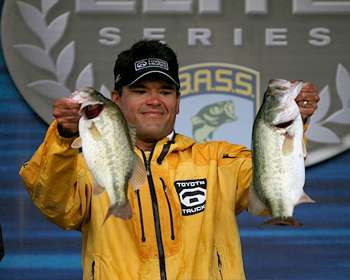
With proven results on the Bassmaster Elite Series, many anglers are beginning to rely on swimming a jig to put bass in the boat. As a response to the technique's growing popularity, many jig manufactures now offer specific jigs designed for swimming. Though popularity is on the rise, most anglers only think of the technique during the summer months.
Elite Series pro Dave Wolak says that relegating the swim jig to summer fishing is a mistake. The North Carolina pro says that when water temperatures cool in the fall, the swim jig shines. "During this time of the year, the bass are chasing shad as they migrate to the backs of creeks and pockets," he points out.
"Swimming a jig is very effective this time of the year, as long as you're targeting the right kinds of areas."
Wolak suggests that the "right" areas will be those that don't have an over-abundance of shad. "Usually, the secondary points on the way to the back of a creek will have a high population of shad this time of the year," he says. "I tend to stay away from them, focusing instead on areas within the creek that have a lot of rock or wood." While it might seem contradictory to focus on areas with relatively few baitfish, Wolak believes that by doing so, his jig will stand out to the bass, making it an easier target.
If grass is present in the lake, all the better; however, hard cover is truly the key. "You'll also want to have depth nearby," Wolak suggests. "I look for cover laden areas where the channel swings close to the bank."
Wolak points out that hard cover and adjacent depth are fundamental to fall fishing — regardless of the technique — due to the extreme weather undulations fall brings. "You'll have schools of shad that move through the areas during this season, but the weather can make their position vary," he says.
"If you have a lot of options for cover the bigger bass will tend to use that area more often than not, regardless of weather changes."
During the fall and early winter, Wolak mentions that his color selection isn't too varied. "I tend to keep my color selection pretty basic when I'm throwing a swim jig in the fall and early winter," he says. "I will only use a couple of shad-patterned skirts on a 1/4-ounce jig and just keep it as close to the surface as possible."
While skirt selection may be basic, he points out that his trailer sizes will vary with the weather and water conditions. "I prefer trailers that have curly appendages," he explains. "This time of the year, more so maybe than the summer, you want to keep your rod tip hopping. By using a trailer that has a lot of innate movement, you can really create a lot of flash as the bait comes through the water."
A buzzbait during the fall of the year can be dynamite as it can replicate schooling shad. For that reason, Wolak recommends "bulging" the water's surface with a swim jig during the fall.
"I'll fish a swim jig for the same reasons that I would fish a buzzbait," he explains. "The difference is that the swim jig is a subtle presentation. You can cover a lot of water in the middle of the day with a swim jig when the fish aren't as aggressive."
(Provided exclusively to BASS Insider by Z3 Media)




